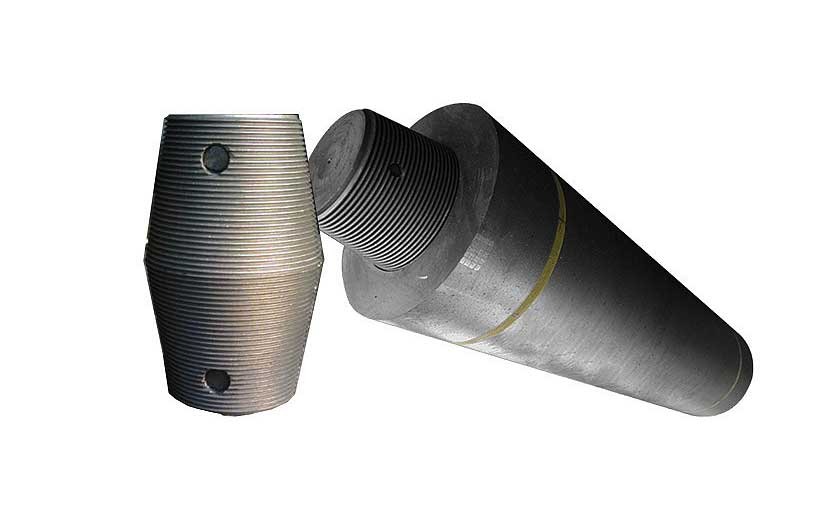The nipple connection area in the graphite electrode column is a common part of fracture, and it is also a complex area with large electrical, thermal, and mechanical loads. There is large thermal stress in this area, so it is also a part that needs to be studied.

Experiment on the Influence of Temperature Distribution of Graphite Electrode Nipples on Thermal Stress
The calculation model selected in the experiment is the connection area formed by the φ500mm high-power electrode and the nipple(φ298.45X 372.5mm). The two sides are symmetrical with the nipple meridian as the midline, and the length is 780mm. And set the calculation model to be located directly above the furnace cover, with a current intensity of 45kA.
According to the structural characteristics of the graphite electrode nipple, the calculation is handled as an axisymmetric problem, and the load is also applied in an axisymmetric manner. In the calculation, it is assumed that the electrode and the nipple are linear elastic bodies, and the difference in the properties of the electrode and the nipple material and the orthogonal anisotropy characteristics, as well as the current steering in the electrode-nipple connection area are considered. The corresponding changes in physical parameters caused by temperature are not considered.
Part of the triangular unit is inserted, the screw contact area unit is encrypted, and the other parts gradually become thinner.
In order to simulate the actual connection conditions, two temperature calculation models are selected in this experiment.
In model 1, it is considered that the electrode bears the effect of the tightening torque. The end faces of the two electrodes are pressed and contacted normally, and the current flows in from the tapered threaded surface at the upper end of the nipple, flows out from the lower end of the nipple, and flows through the contact end faces of the two electrodes at the same time. Model 1 is used to simulate normal connection conditions.
In model 2, a thin layer of the insulator is added to the connecting end of the two electrodes, so that the current can only flow in from the threaded surface of the upper end of the nipple and flow out from the lower end. Model 2 is used to simulate the working condition when the connection end face is loose. The calculated value of this model may be slightly higher than the actual temperature value, but it can fully explain the temperature distribution and the trend of temperature rise.
The surface temperature of graphite electrodes during steelmaking is actually measured. At the end of steel-making melting, when the electrode reaches a steady-state temperature distribution, a handheld fast infrared thermometer is used to record the electrode surface temperature distribution. The measured result is used as the boundary condition of the finite element method to simulate the physical characteristics of the electrode connection area.
The surface temperature of the graphite electrode is measured as a linear distribution from the electrode clamping end to the furnace cover. The surface temperature of the calculated model is about 820~740℃.
The calculation results of experimental data show that. In steelmaking, the electrode connection area above the furnace cover is subjected to heat conduction from the electrodes in the furnace (with higher temperature), current flow through the heat generation, connection factors, and the surrounding environment, which bears a greater thermal load. The temperature distribution is parabolic along the radial direction, and the highest temperature area is in the nipple and threaded connection area. Model 2 shows a steeper temperature gradient and higher nipple temperature, which is almost double that of Model 1, which shows that the nipple bears a greater thermal load.
The following conclusions are obtained through calculation and discussion. In addition to the electrical and thermal properties of the material itself, and the current load, the connection status has a certain effect on the temperature field of the connection area. A certain torque can reduce the temperature, and excessive torque will damage the thread tooth root. Loosening of the connection surface can cause very high temperatures in the nipple.

Recommendations on Graphite Electrode Nipples
The temperature distribution has a certain influence on the size and distribution of thermal stress. Improve the temperature distribution to make it more reasonable, which can improve the thermal stress and reduce the consumption of alkali. Based on the calculation results and analysis, this article puts forward several suggestions.
- (1) Requirements for material performance
- The resistivity should be low. In particular, the electrical resistivity of the nipple is lower than that of the electrode, so that the power (I*R) loss is small and the thermal conductivity is large. The electrodes dissipate quickly and the radial temperature gradient is reduced.
- (2) Best connection status
- Use a torque wrench to apply a suitable connection torque to ensure the strength of the threaded tooth root, while the contact resistance is minimized, and the temperature of the connection area is reduced.
- (3) Sincerely small contact resistance
- Coating a certain substance on the connection surface can increase the friction and reduce the contact resistance value, and has good electrical and thermal conductivity. In addition, the contact area can be increased and the contact resistance can be reduced by changing the shape of the nipple.
- (4) Use a cooling system to lower the temperature.
For more information about graphite electrodes, please follow our website.
